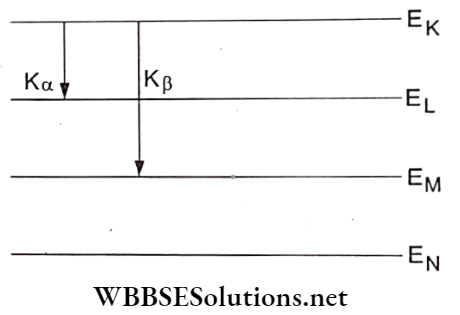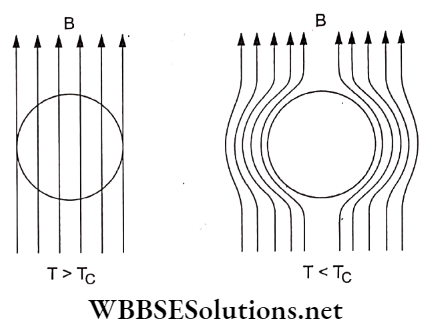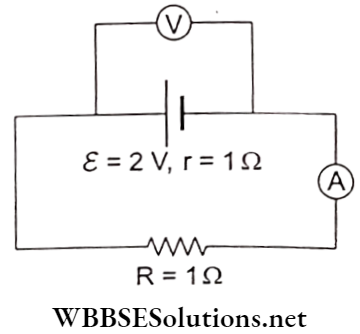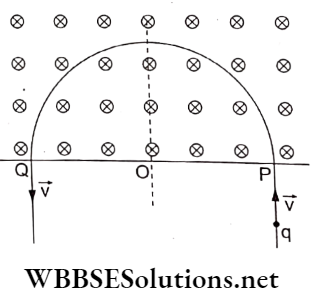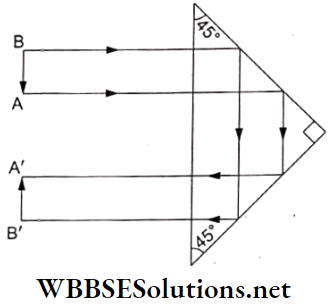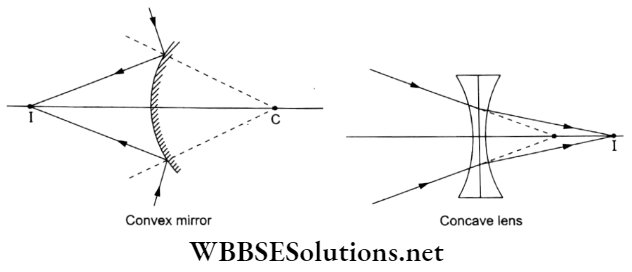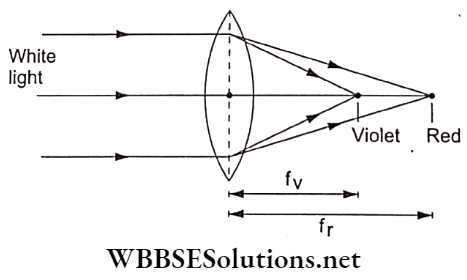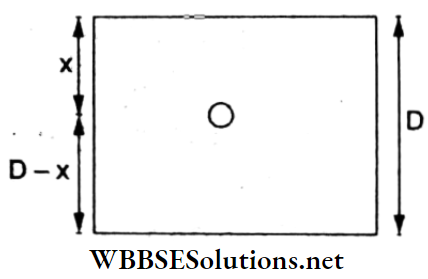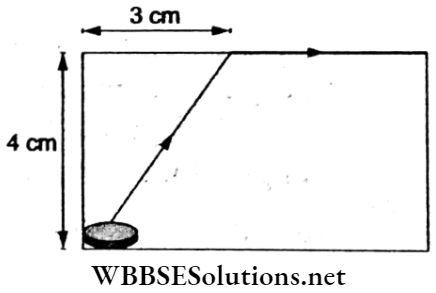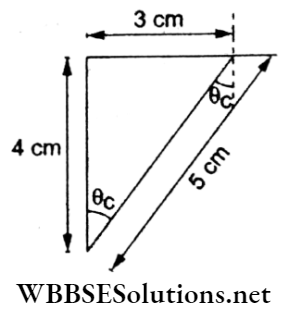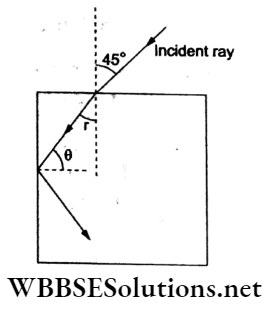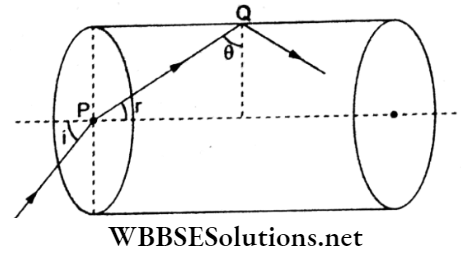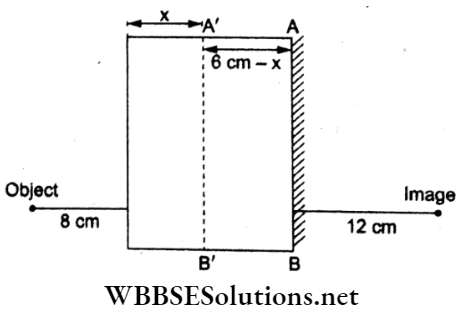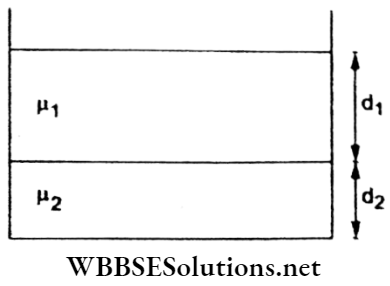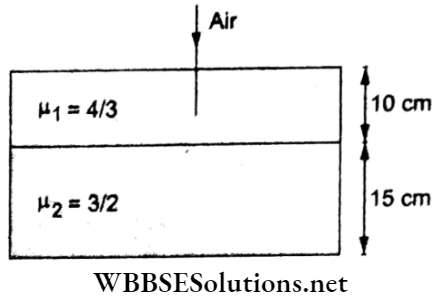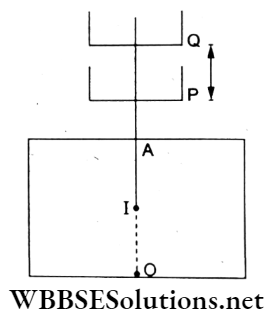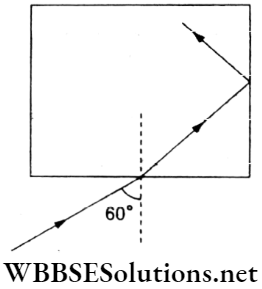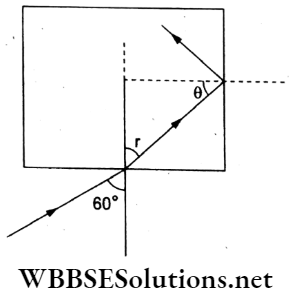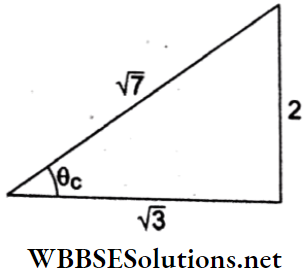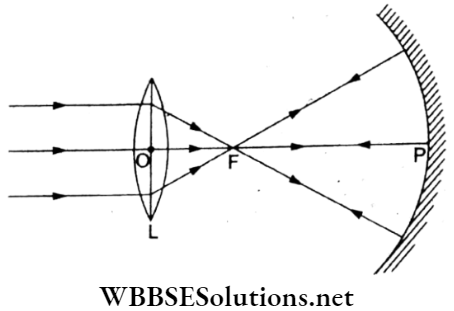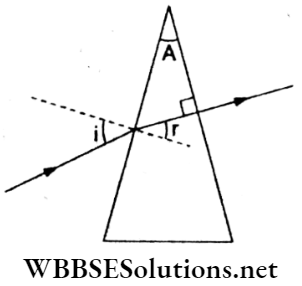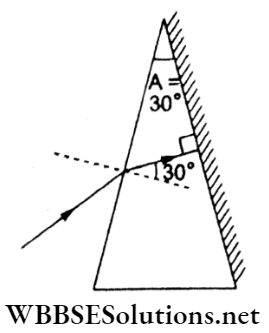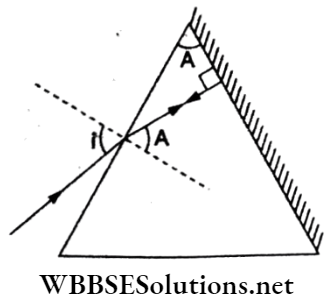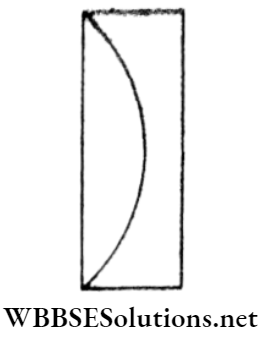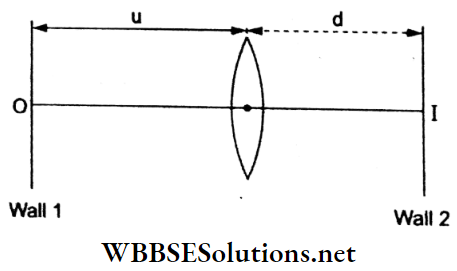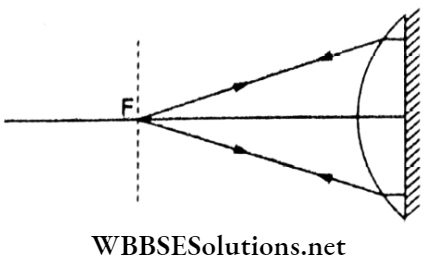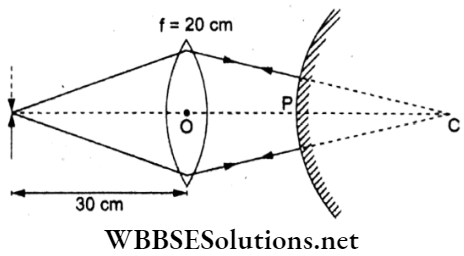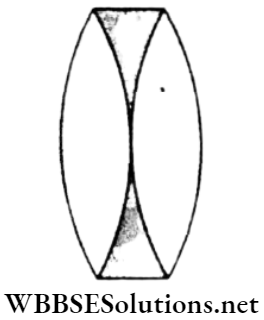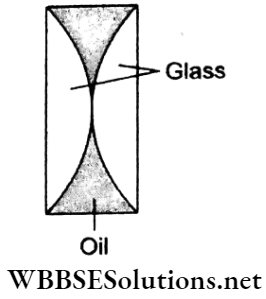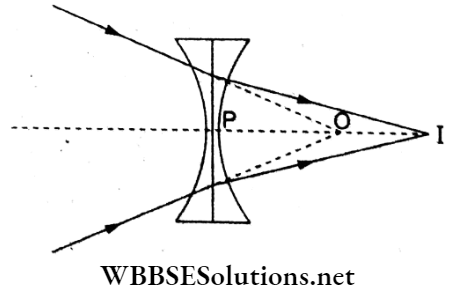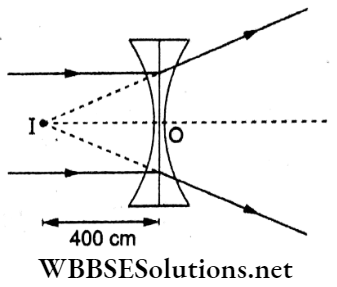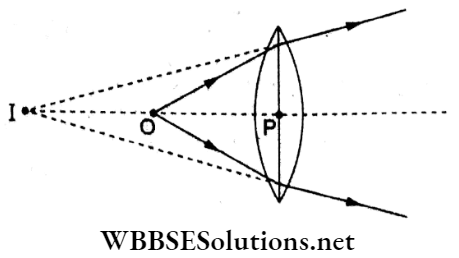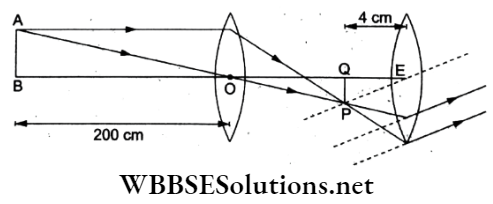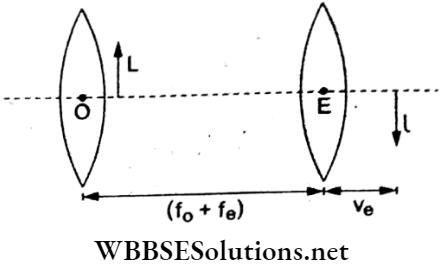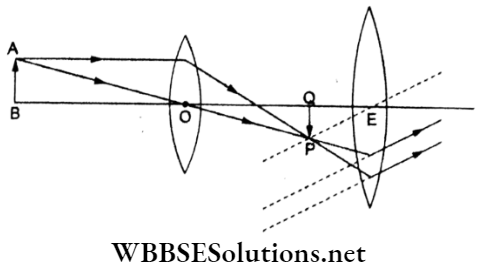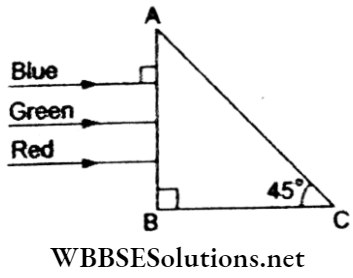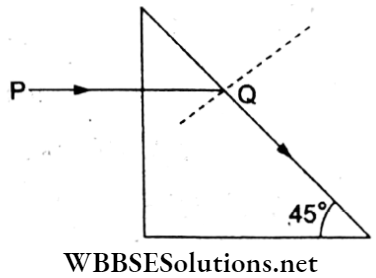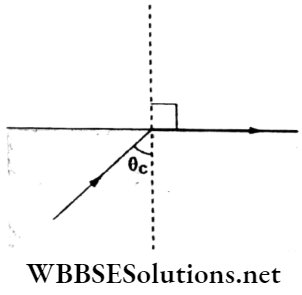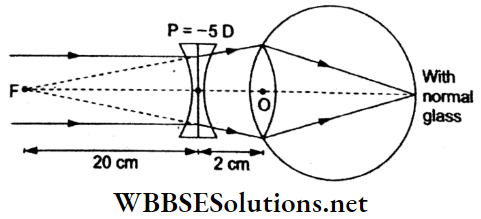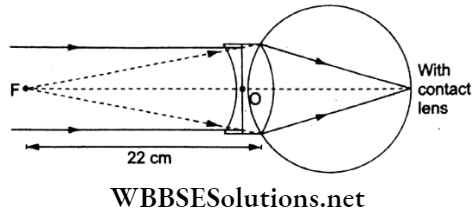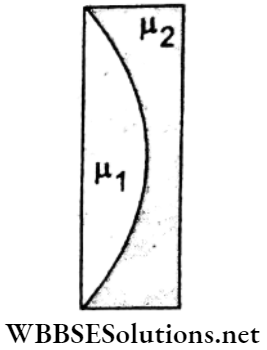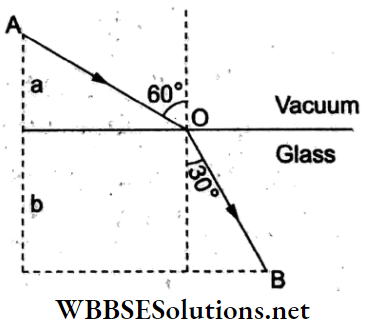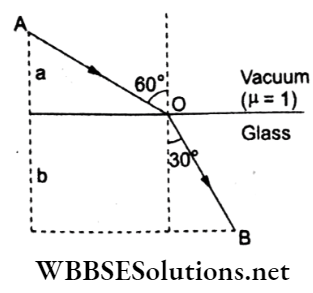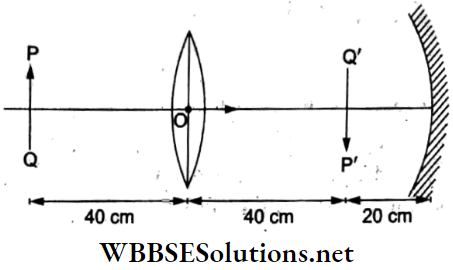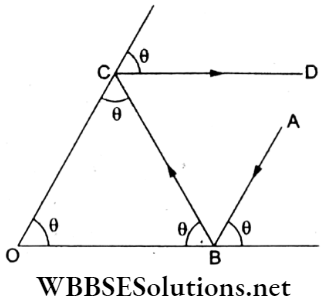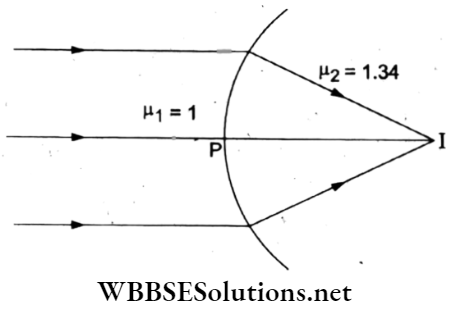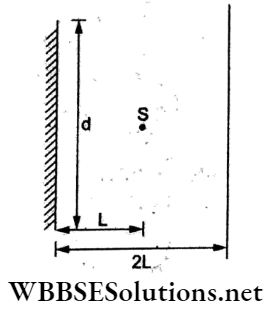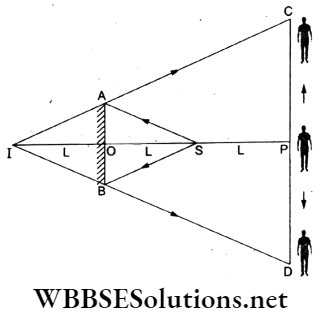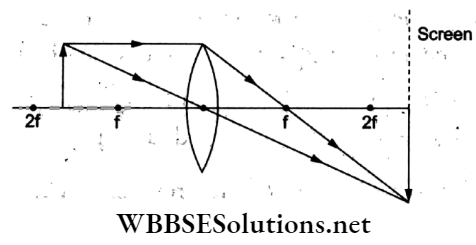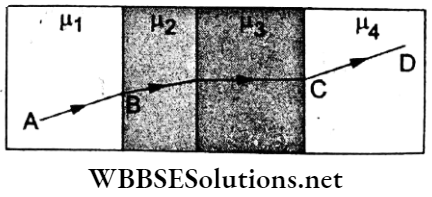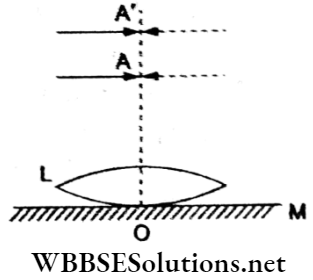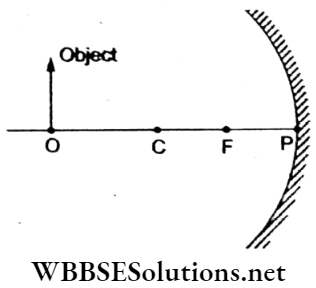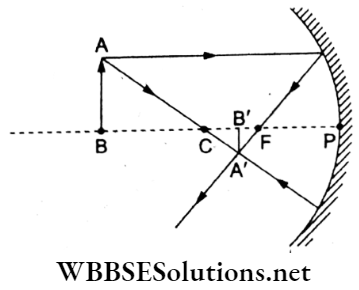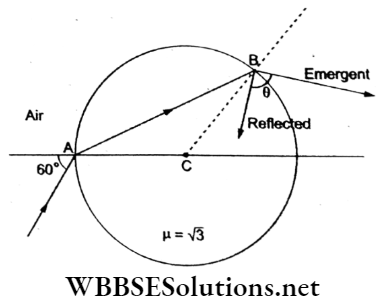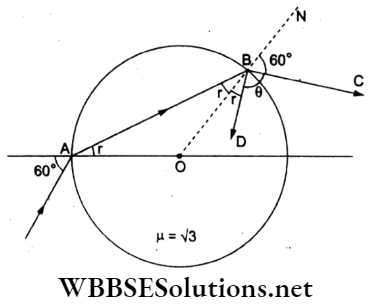General Physics
Each of the following questions comprises two statements. The assertion is expressed by Statement 1 and the reason is expressed by Statement 2.
Each question has four options (1), (2), (3), and (4) as given below, out of which only ONE is correct.
- Statement 1 is true; Statement 2 is true; and Statement 2 is a correct explanation of Statement 1.
- Statement 1 is true; Statement 2 is true; but Statement 2 is not a correct explanation of Statement 1.
- Statement 1 is true and Statement 2 is false.
- Statement 1 is false and Statement 2 is true.
- Both Statement 1 and Statement 2 are false.
Some questions are preceded, by a supporting paragraph in addition to the statements.
Units Dimensions And Errors
Question 1. Statement 1 The dimensional formula for the product of resistance and conductance is the same as that for the dielectric constant.
Statement 2 Both have the dimension of the time constant.
Answer: 3. Statement 1 is true and Statement 2 is false.
Resistance and conductance are reciprocal to each other, hence their product has no units and no dimensions. The same is true for the dielectric constant (K = ε/ε0), which is a ratio of two permittivities. Hence, Statement 1 is true but Statement 2 is false.
Question 2. Statement 1 SI units are logical and coherent.
Statement 2 This system of units is a rationalized system.
Answer: 2. Statement 1 is true; Statement 2 is true; but Statement 2 is not a correct explanation of Statement 1.
A coherent system of units is based on a system of base units from which all derived units are obtained by multiplication or division without introducing numerical factors. Hence, SI units are logical, coherent, and rationalized.
Question 3. Statement 1 The power of an engine depends on mass, angular speed, torque, and angular momentum, so the formula for power is not derived with the help of the dimensional method.
Statement 2 In mechanics, if a particular physical quantity depends on more than three quantities, we cannot derive the formula of that physical quantity using the dimensional method.
Answer: 1. Statement 1 is true; Statement 2 is true; and Statement 2 is a correct explanation of Statement 1.
In mechanics, the physical quantities have dimensions in terms of M, L, and T only. With dependence on more than three factors, the required relation cannot be derived.
Question 4. Statement 1 The order of accuracy in a measurement depends on the least count of the measuring instrument.
Statement 2 The smaller the least count, the greater the number of significant figures in the measured value.
Answer: 2. Statement 1 is true; Statement 2 is true; but Statement 2 is not a correct explanation of Statement 1.
Both the statements are independently correct.
Question 5. Statement 1 The mass of an object is 24.6 kg. This value contains three significant digits.
Statement 2 The value of the same mass when expressed as 24600 g has five significant digits.
Answer: 3. Statement 1 is true and Statement 2 is false.
The degree of accuracy and hence the number of significant digits of a measurement cannot be increased by changing the unit of a physical quantity.
Question 6. Statement 1 The dimensional method cannot be used to derive the relationship among the work done (W) by a force (F), the displacement (s), and the angle (0) between the directions of \(\vec{F}\) and \(\vec{s}\).
Statement 2 All trigonometric functions are dimensionless.
Answer: 1. Statement 1 is true; Statement 2 is true; and Statement 2 is a correct explanation of Statement 1.
Work done = W = Fs cos θ. Since cos θ is dimensionless, the dependence of W on cos θ cannot be determined.
Question 7. Statement 1 The dimensional formula for RC is the same as that for L/R, where L, C, and R represent, capacitance and resistance respectively.
Statement 2 Both RC and L/R have the dimensions of frequency.
Answer: 3. Statement 1 is true and Statement 2 is false.
The dimensions of both L/R and CR are that of time and not of frequencies, as given in Statement 2.
Motion In A Straight Line
Question 1. Statement 1 The speedometer of an automobile measures the average speed of the automobile.
Statement 2 The average velocity is equal to the total distance divided by the total time taken.
Answer: 5. Both Statement 1 and Statement 2 are false.
The speedometer measures the instantaneous speed of an automobile.
The average velocity is a vector quantity and is measured by
∴ \(\vec{v}_{\mathrm{av}}=\frac{\text { net displacement }}{\text { time taken }}\)
Question 2. Statement 1 The relative velocity between any two objects moving in opposite directions is equal to the sum of the velocities of the two objects.
Statement 2 Sometimes the relative velocity between two objects is equal to the difference in velocities of the two objects.
Answer: 2. Statement 1 is true; Statement 2 is true; but Statement 2 is not a correct explanation of Statement 1.
When two objects move in opposite directions, the magnitude of relative velocity is equal to the sum of their velocities. When their motion is in the same direction, the relative velocity is equal to the difference of the two velocities.
Question 3. Statement 1 The displacement of a particle may be zero, whereas the distance traveled by it is not zero.
Statement 2 The displacement is the longest distance between the initial and final positions.
Answer: 3. Statement 1 is true and Statement 2 is false.
When a particle completes a closed loop, its displacement is zero but the distance covered is nonzero! The displacement is measured by the areal distance, or the shortest distance between the two points, not the longest distance.
Question 4. Statement 1 A body can have an acceleration even if its velocity is zero at that instant of time.
Statement 2 A body comes to a momentary rest when it reverses its direction of motion.
Answer: 1. Statement 1 is true; Statement 2 is true; and Statement 2 is a correct explanation of Statement 1.
Consider the motion of an object projected vertically upwards. At the highest point, the object comes to a momentary rest (v = 0) but gravity still acts (so acceleration ≠ 0). This is given as Statement 2.
Question 5. Statement 1 When a body is thrown horizontally or dropped from the same height, it reaches the ground at the same time.
Statement 2 The horizontal velocity has no effect on the vertical direction.
Answer: 1. Statement 1 is true; Statement 2 is true; and Statement 2 is a correct explanation of Statement 1.
The component of the horizontal velocity along the vertical is zero. So, both the bodies reach the ground at the same time.
Question 6. Statement 1 A particle moving in a straight line at a constant speed must have zero acceleration.
Statement 2 A particle moving along a curve at a constant speed may have zero acceleration.
Answer: 3. Statement 1 is true and Statement 2 is false.
A body moving along a curved path changes its direction continuously and represents an accelerated motion.
Question 7. Statement 1 If the displacement-time graph of the motion of a body is a straight line parallel to the time axis, it follows that the body is at rest.
Statement 2 The time rate of change of displacement measures the instantaneous velocity.
Answer: 1. Statement 1 is true; Statement 2 is true; and Statement 2 is a correct explanation of Statement 1.
The instantaneous velocity is the slope of the displacement-time graph \((\vec{v}=\overrightarrow{d x} / d t)\)
For the zero slope, \(\vec{v}=\overrightarrow{0}\)
Question 8. Statement 1 If the velocity-time graph of a particle in motion is a curve then the particle is either uniformly accelerated or uniformly retarded.
Statement 2 The slope of the velocity-time graph gives the instantaneous acceleration.
Answer: 4. Statement 1 is false and Statement 2 is true.
The slope of the v-t graph gives the instantaneous acceleration. The slope changes continuously if the v-t graph is a curve.
Question 9. Statement 1 In a uniform circular motion, the kinetic energy of a body remains constant.
Statement 2 The momentum of the body does not change with time.
Answer: 3. Statement 1 is true and Statement 2 is false.
The kinetic energy is given by
∴ \(E_{\mathrm{k}}=\frac{1}{2}\left(\frac{\vec{p} \cdot \vec{p}}{m}\right)=\frac{p^2}{2 m}\), which remains constant with time.
But the momentum \((\vec{p})\) is a vector which changes with a change in
direction.
Motion In A Plane
Question 1. Statement 1 Two balls of different masses are projected vertically upwards with the same speed. They will pass through their point of projection simultaneously in the downward direction.
Statement 2 The maximum height and the downward velocity attained at the point of projection are independent of the masses of the balls.
Answer: 1. Statement 1 is true; Statement 2 is true; and Statement 2 is a correct explanation of Statement 1.
A motion under gravity has a constant acceleration \(\vec{g}\) The maximum height and the downward velocity at the point of projection are independent of the mass of the body.
Question 2. Statement 1 Electric current and time both have directions as well as magnitudes. But they are not considered to be vectors.
Statement 2 They do not follow the laws of vector addition.
Answer: 1. Statement 1 is true; Statement 2 is true; and Statement 2 is a correct explanation of Statement 1.
Electric current and time add up scalarly and not like vectors. Hence, they are both scalars and not vectors.
Question 3. Statement 1 When a ball is projected at an angle of 45°, its range is maximum.
Statement 2 For the range to be maximum, the value of sin 20 should be equal to unity.
Answer: 1. Statement 1 is true; Statement 2 is true; and Statement 2 is a correct explanation of Statement 1.
In a projectile motion, the horizontal range is given by R = \(\left(u^2 \sin 2 \theta\right) / g\), and R is maximum when sin 2θ is maximum (= 1), i.e., when θ = 45°.
Question 4. Statement 1 A stone of mass m is tied to a stone of radius R and is whirled in a vertical circle. The minimum speed at the topmost point is \(\sqrt{g R}\).
Statement 2 At the topmost point, the centripetal force is provided partly by the weight (mg) of the stone and partly by the tension in the string.
Answer: 1. Statement 1 is true; Statement 2 is true; and Statement 2 is a correct explanation of Statement 1.
At the topmost point in the vertical circle, the weight and tension taken together provide the required centripetal force. For the minimum speed, tension T = 0. So, \(v_{\min }=\sqrt{g R}\)
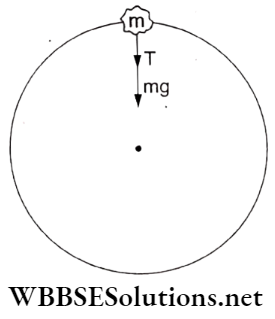
Question 5. Statement 1 In javelin throwing, the athlete throws the projectile at an angle slightly more than 45°.
Statement 2 The maximum horizontal range depends on the angle of projection.
Answer: 4. Statement 1 is false and Statement 2 is true.
The maximum range R = \(\left(u^2 \sin 2 \theta\right) / g\) does depend on the angle of projection θ (= 45°).
Question 6. Statement 1 When the velocity of projection of a body is made n times, its time of flight becomes n times.
Statement 2 The range of a projectile does not depend on the initial velocity of the projectile.
Answer: 3. Statement 1 is true and Statement 2 is false.
Time of flight = \(T=\frac{2 u \sin \theta}{g}\)
If \(u^{\prime}=n u, T^{\prime}=\frac{2(n u) \sin \theta}{g}=n T\)
Thus, Statement 1 is true but Statement 2 is false, as the range (R) depends on u and θ both.
Question 7. Statement 1 Generally, the path of a projectile from the earth is parabolic. But it is elliptical for a projectile going up to a very great height.
Statement 2 Up to an ordinary height, a projectile moves under a uniform gravitational force. But for a great height, a projectile moves under a variable force.
Answer: 1. Statement 1 is true; Statement 2 is true; and Statement 2 is a correct explanation of Statement 1.
The path followed by a projectile is parabolic for the heights h«RE, where RE is the radius of the earth. The gravity g remains constant. But for the heights h» RE,g decreases significantly, leading to an elliptical path.
Question 8. Statement 1 A cyclist leans inwards while taking a turn, whereas a person sitting in a car leans outwards on a curve.
Statement 2 A centripetal acceleration is acting toward the center of the curve.
Answer: 1. Statement 1 is true; Statement 2 is true; and Statement 2 is a correct explanation of Statement 1.
In taking a turn, the cyclist needs a centripetal force towards the center. This force is provided by the frictional force acting between the tires and the ground.
The person sitting in a car is in an accelerated frame and leans outwards due to the pseudo force generated.
Question 9. Statement 1 The position of a particle in the xy-plane is expressed by x = a sin ωt and y = a(1- cos ωt), where a and ω are constants. Then, the particle will have a parabolic motion.
Statement 2 A particle under the influence of two mutually perpendicular velocities does not take a parabolic path.
Answer: 4. Statement 1 is false and Statement 2 is true.
The path followed by the particle will be a circle of radius centered on (0, a), as given below.
⇒ \(\sin \omega t=\frac{x}{a} \text { and } \cos \omega t=1-\frac{y}{a}\)
∴ \(\left(\frac{x}{a}\right)^2+\left(1-\frac{y}{a}\right)^2=1\)
⇒ x2 + (y-a)2 = a2.
So, Statement 1 is false. Under two mutually perpendicular velocities, the path followed will not be a parabola.
Question 10. Statement 1 In a uniform circular motion, the centripetal force is always perpendicular to the velocity vector.
Statement 2 The velocity vector at a point is always along the tangent to the trajectory at the point.
Answer: 1. Statement 1 is true; Statement 2 is true; and Statement 2 is a correct explanation of Statement 1.
In a uniform circular motion, the speed is constant, so KE = constant.
Hence, work done = \(\vec{F} \cdot \vec{s}=0\)
So, \(\vec{F}\) is perpendicular to the velocity vector.
For any trajectory, the velocity vector has its direction tangential to the trajectory.
Laws Of Motion
Question 1. Statement 1 Frictional forces are nonconservative forces.
Statement 2 A potential energy can be associated with a frictional force.
Answer: 3. Statement 1 is true and Statement 2 is false.
Frictional forces dissipate energy and are thus nonconservative. Potential energies can be stored in conservative forces. So, no potential energy can be assigned to a frictional force.
Question 2. Statement 1 The apparent weight of a body in an elevator moving with some downward acceleration is less than the true weight of the body.
Statement 2 A part of the body’s weight is spent in providing the downward acceleration when the body is in the elevator.
Answer: 1. Statement 1 is true; Statement 2 is true; and Statement 2 is a correct explanation of Statement 1.
We feel our weight by the normal reaction \((\mathcal{N})\) offered by the floor.
For a lift accelerating down, mg – \((\mathcal{N})\) = ma.
∴ apparent weight = \((\mathcal{N})\) = mg- ma, which is less than the true weight mg.
Since mg = \((\mathcal{N})\) + ma, part of mg is spent as ma.
Question 3. Statement 1 Two bodies of masses M and m (where M > m) are allowed to fall from the same height. If the air resistance for each is the same then both the bodies will reach the ground simultaneously.
Statement 2 For the same air resistance, the accelerations of both bodies will not be equal.
Answer: 4. Statement 1 is false and Statement 2 is true.
For the mass M,
∴ \(M g-f=M a_1 \Rightarrow a_1=g-\frac{f}{M}\)
For m, \(a_2=g-\frac{f}{m}\)
Since M>m, a1>a2. Hence, M will reach first and then m. So, Statement 1 is false and Statement 2 is true, since a1 ≠ a2.
Question 4. Statement 1 The use of ball bearings between two moving parts of a machine is a common practice.
Statement 2 The ball bearings reduce rolling friction and provide good stability.
Answer: 1. Statement 1 is true; Statement 2 is true; and Statement 2 is a correct explanation of Statement 1.
Ball bearings reduce rolling friction, and hence using them in machines is a common practice.
Question 5. Statement 1 On a rainy day, it is difficult to drive a car or a bus at a high speed.
Statement 2 The value of the coefficient of friction is lowered on wetting the surface.
Answer: 1. Statement 1 is true; Statement 2 is true; and Statement 2 is a correct explanation of Statement 1.
A wet road reduces friction, so the high-speed movement over such a road may lead to skidding.
Question 6. Statement 1 A horse has to pull a cart harder during the first few steps of its motion.
Statement 2 The first few steps are always difficult.
Answer: 3. Statement 1 is true and Statement 2 is false.
The first few steps are harder, as the horse has to overcome the static friction, which is greater than the kinetic friction.
Question 7. Statement 1 A centripetal force is always required for a motion along a curved path.
Statement 2 On a banked curved track, the vertical component of the normal reaction provides the required centripetal force.
Answer: 3. Statement 1 is true and Statement 2 is false.
A centripetal force is always required for a motion along a curved path. On a banked road, the horizontal component of the normal reaction provides the required centripetal force.
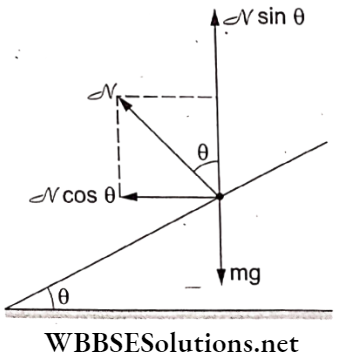
Question 8. Statement 1 A pseudo force is an imaginary force that is recognized only by a noninertial observer to explain the physical situation according to Newton’s laws of motion.
Statement 2 A pseudo force has no physical origin, i.e., it is not caused by the basic interactions in nature. It does not exist in an action-reaction force pair.
Answer: 2. Statement 1 is true; Statement 2 is true; but Statement 2 is not a correct explanation of Statement 1.
In an accelerated (or a noninertial) frame, the observer experiences a pseudo force (= mass of the object x acceleration of the frame with a negative sign = \(-m \vec{a}_{\mathrm{fr}}\)).
However, it is not a field force like gravitational and elastic forces
Question 9. Statement 1 A body subjected to three coplanar concurrent forces may be in equilibrium.
Statement 2 For equilibrium, the vector sum of all the concurrent forces acting at a point should be
Answer: 1. Statement 1 is true; Statement 2 is true; and Statement 2 is a correct explanation of Statement 1.
A body will be in equilibrium if the vector sum of the three concurrent forces acting on it is zero.
Question 10. Statement 1 An animate object can accelerate in the absence of external forces.
Statement 2 Newton’s second law of motion is not applicable to animate objects.
Answer: 4. Statement 1 is false and Statement 2 is true.
When we apply the second law of motion, there is no distinction between whether the object is animate or inanimate. An animate object always requires an external force in order to produce an acceleration.
Question 11. Statement 1 It is difficult to move a cycle along the road with its brakes on.
Statement 2 The degree of sliding friction is always greater than that of rolling friction.
Answer: 1. Statement 1 is true; Statement 2 is true; and Statement 2 is a correct explanation of Statement 1.
With the brakes on, there is no rolling but sliding. Sliding friction is greater than rolling friction, which makes the movement difficult.
Question 12. Statement 1 An impulsive force is large and acts for a short period of time.
Statement 2 A finite change in momentum should be produced by the force.
Answer: 1. Statement 1 is true; Statement 2 is true; and Statement 2 is a correct explanation of Statement 1.
A large force acting for a short duration is called an impulsive force. According to the impulse-momentum theorem, a change in momentum is produced by the impulse.
Question 13. Statement 1 The driver in a vehicle moving at a constant speed on a straight road is in a noninertial frame of reference.
Statement 2 A reference frame to which Newton’s laws of motion are applicable is noninertial.
Answer: 5. Both Statement 1 and Statement 2 are false.
A motion along a straight line with a uniform velocity has zero acceleration, and such a reference frame is called an inertial frame. A noninertial frame is an accelerated frame. Newton’s second and third laws are valid only when we consider a pseudo-force.
Question 14. Statement 1 It is easier to pull a heavy object than to push it on a level ground.
Statement 2 The magnitude of frictional force depends on the nature of the two surfaces in contact.
Answer: 2. Statement 1 is true; Statement 2 is true; but Statement 2 is not a correct explanation of Statement 1.
While pulling, the component F cos 0 of the pulling force acts against the weight mg, so that the normal reaction is reduced to \(\mathcal{N}\) = mg- F sin 0.
This reduces the kinetic frictional force \(f_{\mathrm{k}}=\mu \mathcal{N}=\mu(m g-F \sin \theta)\)
While pushing, the normal reaction is increased to \(-\mathcal{N}=m g+F \sin \theta\)
Hence, the frictional force becomes \(f_{\mathrm{k}}=\mu(m g+F \sin \theta)\)
Now, more effort is required to overcome the friction.
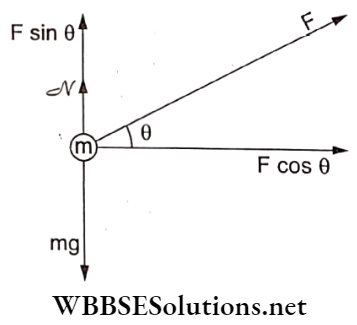
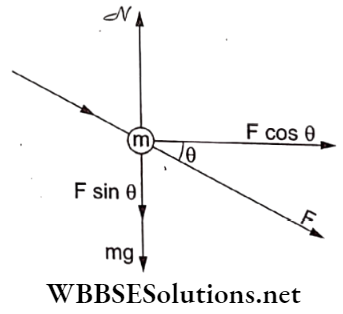
Work Energy Power And Collision
Question 1. Statement 1 In an elastic collision, kinetic energy is conserved.
Statement 2 Energy is always conserved.
Answer: 2. Statement 1 is true; Statement 2 is true; but Statement 2 is not a correct explanation of Statement 1.
In an elastic collision, kinetic energy remains the same before and after the collision. The law of energy conservation is the basic conservation law in nature. Energy may change the form but remains unchanged in total.
Question 2. Statement 1 The work done in a uniform circular motion is zero.
Statement 2 Force is always directed along displacement.
Answer: 3. Statement 1 is true and Statement 2 is false.
In a uniform circular motion, the centripetal force is directed radially inwards, whereas the velocity and displacement vectors are tangential. Hence, work done = W = \(\vec{F} \cdot \vec{s}\) = 0.
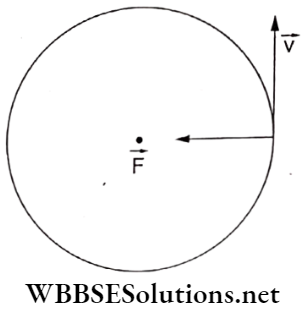
Question 3. Statement 1 If the momentum of a body increases by 50%, its kinetic energy will increase by 125%.
Statement 2 Kinetic energy is directly proportional to the square of velocity.
Answer: 1. Statement 1 is true; Statement 2 is true; and Statement 2 is a correct explanation of Statement 1.
⇒ \(\mathrm{KE}=\frac{1}{2} m v^2\)
If m is constant, KE oc v2.
Again, \(\mathrm{KE}=\frac{m^2 v^2}{2 m}=\frac{p^2}{2 m}=E_1\)
With a 50% increase in momentum,
∴ \(\mathrm{KE}=\frac{1}{2 m}\left(p+\frac{p}{2}\right)^2=\frac{9 p^2}{2 m \times 4}=E_2\)
% increase in \(\mathrm{KE}=\frac{\Delta \mathrm{KE}}{\mathrm{KE}} \times 100 \%=\left(\frac{9}{4}-1\right) 100 \%=125 \%\)
Question 4. Statement 1 The total energy is negative for a bound system.
Statement 2 The potential energy of a bound system is negative and more than the kinetic energy.
Answer: 1. Statement 1 is true; Statement 2 is true; and Statement 2 is a correct explanation of Statement 1.
The total energy (KE + PE) of a bound system (like the electron-nucleus system in an atom, the earth-sun system, or an earth-satellite system) is always negative with a negative PE (greater than KE in magnitude). The energy required to detach the component is called the binding energy.
Question 5. Statement 1 A centripetal force does no work.
Statement 2 Force and displacement are mutually perpendicular to each other.
Answer: 1. Statement 1 is true; Statement 2 is true; and Statement 2 is a correct explanation of Statement 1.
Centripetal force and displacement are mutually perpendicular, Hence, the work done is zero.
Question 6. Statement 1 A rigid body can be elastic.
Statement 2 If a force is applied to a rigid body, its dimensions may change.
Answer: 5. Both Statement 1 and Statement 2 are false.
A rigid body is a solid body in which the deformation is zero or so small that it can be neglected. The separation between any two given points remains constant regardless of the external forces exerted on it.
Question 7. Statement 1 The work done in moving a body over a closed loop is zero for every force in nature.
Statement 2 Work does not depend on the nature of force.
Answer: 4. Statement 1 is false and Statement 2 is true.
The work done over a closed loop is zero only for conservative forces (like gravitational and electrostatic forces). But it is nonzero for nonconservative forces (like friction).
Question 8. Statement 1 The kinetic energy is conserved at every instant during an elastic collision.
Statement 2 No deformation of matter occurs during an elastic collision.
Answer: 4. Statement 1 is false and Statement 2 is true.
A collision is always associated with a deformation for a very short duration. In the process, the KE is converted into PE (during compression) and thereafter back to the same amount of KE during an elastic collision.
Question 9. Statement 1 A quick collision between two bodies is more violent than a slow collision even when the initial and final velocities are identical.
Statement 2 The rate of change of momentum is greater in the first case.
Answer: 1. Statement 1 is true; Statement 2 is true; and Statement 2 is a correct explanation of Statement 1.
According to the impulse-momentum theorem, FΔt = Δp, where F = impact force, Δt = time of impact, and Δp = change in momentum. For the same value of Δp, FΔt = F’Δt’. For a quick collision, Δt is small, so F is large and more violent. For a large Af, F’ is small.
Since F > F’, the rate of change of momentum is
∴ \(\frac{\Delta p}{\Delta t}>\frac{\Delta p}{\Delta t^{\prime}}\)
Question 10. Statement 1 In an elastic collision between two billiard balls, the total kinetic energy is conserved during the short duration of the collision of balls (i.e., as long as they are in contact).
Statement 2 The energy spent against friction still follows the law of conservation of energy.
Answer: 4. Statement 1 is false and Statement 2 is true.
In an elastic collision, there is an exchange between the KE and the elastic PE during the short duration of the impact. So, Statement 1 is false. The energy spent by the frictional force is converted to heat energy. So, energy conservation still follows.
Question 11. Statement 1 A particle collides head-on with another stationary particle such that the first particle comes to rest after the collision. The collision should necessarily be elastic.
Statement 2 In an elastic collision, there is a loss in the momentum of the system of particles.
Answer: 3. Statement 1 is true and Statement 2 is false.
When two particles of equal masses collide elastically, their velocities are mutually interchanged. The linear momentum is always conserved and is valid for all types of collisions.
Question 12. Statement 1 During an elastic collision between two bodies, the relative speed of the approach before the collision is equal to the relative speed of separation after the collision.
Statement 2 In an elastic collision, the linear momentum of the system remains conserved.
Answer: 2. Statement 1 is true; Statement 2 is true; but Statement 2 is not a correct explanation of Statement 1.
The coefficient of restitution is given by
∴ \(e=\frac{\text { relative speed of separation }}{\text { relative speed of approach }}\)
For an elastic collision, e = l. The law of conservation of linear momentum is always true for all types of collisions.
Question 13. Statement 1 In a one-dimensional elastic head-on collision, the total linear momentum remains unchanged before, during, and after the collision.
Statement 2 In a one-dimensional elastic head-on collision, the total kinetic energy remains the same before, during, and after the collision.
Answer: 3. Statement 1 is true and Statement 2 is false.
At the moment the balls A and B collide, A has a larger velocity than that of B, i.e., v1 > v2. But the contact surfaces move through equal distances in equal intervals of time as long as the contact is maintained. During the contact, A and B push each other and the velocities change such that the total momentum still remains unchanged. When some deformation occurs, the total kinetic energy of the system decreases as some energy is stored as elastic compressional potential energy. When the deformation is maximum, the kinetic energy is minimum and the two balls attain equal velocities.
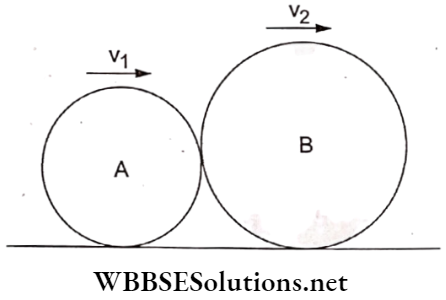
Rotation
Question 1. Statement 1 If the polar ice melts, days will be longer.
Statement 2 Moment of inertia increases and thus angular velocity decreases.
Answer: 1. Statement 1 is true; Statement 2 is true; and Statement 2 is a correct explanation of Statement 1.
When the polar ice melts, there is a shift of mass from the axis of rotation to away from the axis. This increases the moment of inertia. Since the angular momentum remains constant, ω will decrease and the duration of a day will increase.
Question 2. Statement 1 The earth is slowing down and consequently the moon is coming nearer to it.
Statement 2 The angular momentum of the earth-moon system is always conserved.
Answer: 4. Statement 1 is false and Statement 2 is true.
The earth is not slowing down and the angular momentum of the earth-moon system is always conserved.
Question 3. Statement 1 For a system of particles under a central force field, the angular momentum is conserved.
Statement 2 The torque acting on such a system is zero.
Answer: 1. Statement 1 is true; Statement 2 is true; and Statement 2 is a correct explanation of Statement 1.
Under the central force, \(\vec{F}\) and \(\vec{r}\) are directed along the same line. So, torque = \(\vec{\tau}=\vec{r} \times \vec{F}=\overrightarrow{0}\) . Hence, the angular momentum is conserved.
Question 4. Statement 1 A solid sphere is rolling on a rough horizontal surface. The acceleration of the contact point is zero.
Statement 2 A solid sphere can not roll on a smooth surface.
Answer: 4. Statement 1 is false and Statement 2 is true.
For a pure rolling motion on a horizontal plane, the relative velocity of the point of contact and the tangential acceleration are both zero, but still, there is a radial acceleration directed towards the center. On a smooth surface, the sphere will undergo slipping due to the absence of friction.
Question 5. Statement 1 Moment of inertia is always constant.
Statement 2 Angular momentum is conserved which is why the moment of inertia is conserved.
Answer: 5. Both Statement 1 and Statement 2 are false.
The moment of inertia about a given axis is not constant but depends on the distribution of mass relative to the axis of rotation.
Further, angular momentum is conserved only in the absence of an external torque.
Question 6. Statement 1 The value of the radius of the gyration of a body depends on the axis of rotation.
Statement 2 The radius of gyration of a body is the root-mean-square distance of the particles of the body from the axis of rotation.
Answer: 1. Statement 1 is true; Statement 2 is true; and Statement 2 is a correct explanation of Statement 1.
The radius of gyration (k) of a body depends on the position of the axis of rotation and the distribution of mass around it. Considering the particles of the same mass, we have
∴ \(k=\sqrt{\frac{r_1^2+r_2^2+\ldots+r_n^2}{n}}\) = rms distance.
Question 7. Statement 1 The size and shape of the rigid body remain unaffected under the effect of external forces.
Statement 2 The distance between two particles remains constant in a rigid body.
Answer: 1. Statement 1 is true; Statement 2 is true; and Statement 2 is a correct explanation of Statement 1.
A rigid body is an ideal concept in which the separation between any of its two particles and the shape and size of the body remain unaffected by external forces and torques.
Question 8. Statement 1 The center of mass of a system does not move under the action of internal forces.
Statement 2 Internal forces are not conservative forces.
Answer: 3. Statement 1 is true and Statement 2 is false.
The acceleration of the center of mass of a system of particles is due only to the external forces acting on the system, and the interval forces have no contributions in accelerating the center of mass. Internal forces always act in pairs (like an action-reaction pair) and they add up to zero for the whole system. Hence, the motion of the center remains unaffected.
Inertial forces are pseudo forces and exist only in noninertial frames to ensure the validity of Newton’s second law.
Question 9. Statement 1 A judo fighter in order to throw his opponent onto the mat tries to bend his opponent initially and then rotate him around his hip.
Statement 2 As the mass of the opponent is brought closer to the fighter’s hip, the force required to throw the opponent is reduced.
Answer: 1. Statement 1 is true; Statement 2 is true; and Statement 2 is a correct explanation of Statement 1.
The rotation of the opponent makes it difficult for the person rotated to resist. By bringing him closer to the hip, the moment of inertia of the opponent is reduced.
Question 10. Statement 1 A wheel moving down a perfectly smooth inclined plane will undergo a slipping (not rolling) motion.
Statement 2 For a perfect rolling motion, the work done against friction is zero.
Answer: 2. Statement 1 is true; Statement 2 is true; but Statement 2 is not a correct explanation of Statement 1.
In the absence of friction on a smooth incline, no frictional torque required for rolling is available. So, the wheel slips.
For a perfectly rolling motion, friction is static and the work done against friction is zero.
Question 11. Statement 1 If the ice cap of the poles melts, the duration of a day will shorten.
Statement 2 Ice will flow towards the equator and increase the moment of inertia of the earth.
Answer: 4. Statement 1 is false and Statement 2 is true.
When the polar ice melts, it spreads over the surface and the moment of inertia increases. In order to conserve the angular momentum, the angular velocity decreases, which increases the duration of a day.
Question 12. Statement 1 The velocity of a body at the bottom of an inclined plane of a given height is more when it slides down the plane compared to when it is rolling down the same plane.
Statement 2 In rolling down, a body acquires kinetic energies of both translation and rotation.
Answer: 1. Statement 1 is true; Statement 2 is true; and Statement 2 is a correct explanation of Statement 1.
During sliding, the total potential energy is converted into kinetic energy. Thus, at the bottom, \(v=\sqrt{2 g h}\). When the body rolls down the plane, the PE is partly converted into KE of translation \(\left(\frac{1}{2} m v^2\right)\) and partly into KE of rotation \(\left(\frac{1}{2} I \omega^2\right)\)
∴ \(v^{\prime}=\sqrt{\frac{2 g h}{1+\frac{k^2}{R^2}}}=\frac{v}{\sqrt{1+\frac{k^2}{R^2}}} \Rightarrow v^{\prime}<v\)
Question 13. Statement 1 There are very small sporadic changes in the period of rotation of the earth.
Statement 2 Shifting of large air masses in the earth’s atmosphere produces a change in the moment of inertia of the earth, causing its period of rotation to change.
Answer: 1. Statement 1 is true; Statement 2 is true; and Statement 2 is a correct explanation of Statement 1.
Shifting of large air masses produces a change in the earth’s moment of inertia, and to keep the angular momentum constant, the period of rotation is changed.
Gravitation
Question 1. Statement 1 An astronaut experiences weightlessness in a space satellite.
Statement 2 When a body falls freely, it does not experience gravity.
Answer: 2. Statement 1 is true; Statement 2 is true; but Statement 2 is not a correct explanation of Statement 1.
A satellite orbiting the Earth is falling (accelerating towards the Earth), but its tangential speed keeps it away from hitting the surface of the Earth.
Objects (or astronauts) in an orbit are said to experience weightlessness. They do have a gravitational force acting on them, but the satellite and all its contents are in free fall, and the absence of any normal reaction leads to the experience of weightlessness.
Question 2. Statement 1 Comets do not obey Kepler’s laws of planetary motion.
Statement 2 Comets have highly elliptical orbits.
Answer: 4. Statement 1 is false and Statement 2 is true.
Comets go around the sun in a highly elliptical orbit. Like all orbiting bodies, comets also follow Kepler’s second law: the closer they are to the sun, the faster they move.
Question 3. Statement 1 A planet is a heavenly body revolving around the sun.
Statement 2 A star is a luminous body made of gaseous material.
Answer: 2. Statement 1 is true; Statement 2 is true; but Statement 2 is not a correct explanation of Statement 1.
The planets in the solar system orbit the sun under its gravitational force.
Stars are luminous celestial objects containing hydrogen and helium held together by their own gravity.
Question 4. Statement 1 The difference in the values of the acceleration due to gravity at the poles and that at the equator is proportional to the square of the angular speed of the earth.
Statement 2 The value of acceleration due to gravity is minimum at the equator and maximum at the poles.
Answer: 2. Statement 1 is true; Statement 2 is true; but Statement 2 is not a correct explanation of Statement 1.
At the poles, \(g_{\mathrm{P}}=g=\frac{G M_{\mathrm{E}}}{R_{\mathrm{E}}^2}\)
At the equator, \(g_{\mathrm{eq}}=g-R_{\mathrm{E}} \omega^2\)
∴ \(g_{\mathrm{p}}-g_{\mathrm{eq}}=R_{\mathrm{E}} \omega^2 \propto \omega^2\)
Hence, geq is the minimum value of the acceleration due to gravity.
Question 5. Statement 1 The earth without its atmosphere would be inhospitably cold.
Statement 2 All heat would escape the earth in the absence of the atmosphere.
Answer: 1. Statement 1 is true; Statement 2 is true; and Statement 2 is a correct explanation of Statement 1.
The atmosphere protects life on the earth by absorbing the solar UV radiations warming the surface through heat retention and reducing the temperature extremes between day and night The moon has no atmosphere and its temperature in sunlight is around 122 °C. The moon’s surface freezes at -152.7 °C at night; and a similar would be the case with the earth, whose surface would be inhospitably cold without its atmosphere.
Question 6. Statement 1 Water kept in an open vessel will quickly evaporate on the surface of the moon.
Statement 2 The temperature at the surface of the moon is much higher than the boiling point of water.
Answer: 2. Statement 1 is true; Statement 2 is true; but Statement 2 is not a correct explanation of Statement 1.
Due to the negligibly low pressure on the moon, water evaporates quickly. During the daytime, the temperature is very high (above the water’s boiling point) and water will boil.
Question 7. Statement 1 The time period of revolution of a satellite around the planet is directly proportional to the radius of the orbit of the satellite.
Statement 2 Artificial satellites follow Kepler’s laws of planetary motion.
Answer: 4. Statement 1 is false and Statement 2 is true.
Kepler’s laws of planetary motion are followed by the orbital motion of artificial satellites, like all planetary motions. For such a motion, the square of the time of revolution is directly proportional to the cube of the radius of the orbit. Hence, T ∝ R is a false relation.
Question 8. Statement 1 The square of the period of revolution of a planet is proportional to the cube of the semimajor axis of its elliptical orbit.
Statement 2 The sun’s gravitational field is inversely proportional to the square of its distance from the planet.
Answer: 1. Statement 1 is true; Statement 2 is true; and Statement 2 is a correct explanation of Statement 1.
Kepler’s law of periods \(\left(T^2 \propto a^3\right)\) is true. This law is based on Newton’s law of gravitation \(\left(F \propto \frac{1}{r^2}\right)\).
Question 9. Statement 1 If a pendulum falls freely under gravity then its time period becomes infinite.
Statement 2 A freely falling body has an acceleration equal to g.
Answer: 1. Statement 1 is true; Statement 2 is true; and Statement 2 is a correct explanation of Statement 1.
In free fall, there is no normal force or tension, so the bob is in a state of weightlessness, and geff = 0.
Hence, time period = \(T=2 \pi \sqrt{\frac{l}{g_{\text {eff }}}}=\infty\)
A body falling freely under gravity has an acceleration of g.
Question 10. Statement 1 The length of the day is slowly increasing.
Statement 2 The dominant effect causing a slowdown in the rotation of the Earth is the combined gravitational pull of other planets in the solar system.
Answer: 3. Statement 1 is true and Statement 2 is false.
The earth’s rotation is slowing down slightly with time. This is due to the tidal effects the moon has on the Earth’s rotation. This causes a slow increase in the length (duration) of the day. Gravitational pulls are central forces that do not produce any external torques, so angular momenta will remain conserved.
Question 11. Statement 1 A person in a closed cabin falling freely under gravity does not experience gravity.
Statement 2 The inertial mass and the gravitational mass have an equivalence.
Answer: 2. Statement 1 is true; Statement 2 is true; but Statement 2 is not a correct explanation of Statement 1.
We feel our weight by. the normal force exerted by the surface in contact. From the adjoining figure,
⇒ \(F_{\text {net }}=m g-\mathcal{N} \text { but } F_{\text {net }}=m g\)
∴ \(\mathcal{N}=0\)
Hence, it is a state of effective weightlessness.
Mass is always equal to the ratio F/a. So, gravitational and inertial masses are equal.
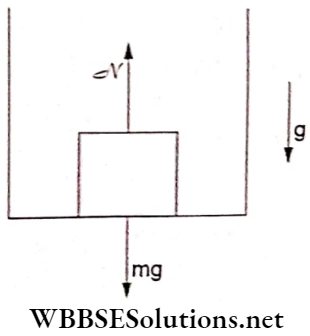
Question 12. Statement 1 Kepler’s second law can be understood by the principle of conservation of angular momentum.
Statement 2 Kepler’s second law is related to areal velocity, which can further be proved to be based on the principle of conservation of angular momentum as \(\frac{d A}{d t}=\frac{1}{2} r^2 \omega\).
Answer: 1. Statement 1 is true; Statement 2 is true; and Statement 2 is a correct explanation of Statement 1.
Kepler’s second law (areal velocity = constant) leads to the principle of conservation of angular momentum.
Question 13. Statement 1 The angular speed of a planet orbiting around the sun increases when it is closer to the sun.
Statement 2 The total angular momentum of the system remains constant.
Answer: 1. Statement 1 is true; Statement 2 is true; and Statement 2 is a correct explanation of Statement 1.
From Kepler’s second law,
∴ \(\frac{1}{2} r^2-\frac{d \theta}{d t}=\cos x\),
Where \(\frac{d \theta}{d t}=\omega\) is the angular velocity.
When the planet is closer to the sun, r decreases, so ω increases.
This is linked with the principle of conservation of angular momentum.
Question 14. Statement 1 The total energy is conserved in moving a satellite to a higher orbit.
Statement 2 The sum of the changes in KE and PE is the same in magnitudes but opposite in nature.
Answer: 3. Statement 1 is true and Statement 2 is false.
The total mechanical energy (= KE + PE) of an artificial satellite orbiting the earth is \(E=-\frac{G M_E m}{2\left(R_E+h\right)}\), where ME is the mass of the earth and RE is the radius of the orbit. When raised to a higher orbit, h increases and E also increases (i.e., becomes less negative). The difference in energy is given by the system, so the energy is conserved.
Question 15. Statement 1 At the poles, the values of the acceleration due to gravity (g) are greater than that at the equator.
Statement 2 The earth rotates on its axis in addition to its revolution around the sun.
Answer: 1. Statement 1 is true; Statement 2 is true; and Statement 2 is a correct explanation of Statement 1.
At the equator, \(g_{\mathrm{eq}}=g-\omega^2 R_{\mathrm{E}}\) nd at the poles, gp = g. Thus, gp > geq. This change is due to the rotation (spin) of the earth about its own axis as well as to the unequal distances of the poles and the equator from the earth’s center.
Question 16. Statement 1 A geostationary satellite must be located in the equatorial plane at some point vertically above the equator.
Statement 2 The only external force acting on an artificial satellite is directed toward the centre of the earth.
Answer: 1. Statement 1 is true; Statement 2 is true; and Statement 2 is a correct explanation of Statement 1.
A geostationary satellite is located in a circular orbit at a height of 35786 km above the Earth’s equator in the equatorial plane so that it appears motionless at a fixed position in the sky to an observer on the Earth.
For the circular motion of the satellite, the gravitational attraction by the earth provides the required centripetal force.
Question 17. Statement 1 The gravitational potential energy of a solid sphere is negative.
Statement 2 Two bodies attract each other
Answer: 1. Statement 1 is true; Statement 2 is true; and Statement 2 is a correct explanation of Statement 1.
In an attractive field, the potential energy is always negative. Gravitation is a conservative attractive force. So, a sphere requires some energy to pull apart all its fragments, so that the PE increases from the negative value to zero.
Simple Harmonic Motion
Question 1. Statement 1 The periodic time of a hard spring is less as compared to that of a soft spring.
Statement 2 The periodic time depends on the spring constant, which is larger for hard springs.
Answer: 1. Statement 1 is true; Statement 2 is true; and Statement 2 is a correct explanation of Statement 1.
The time period of a spring-block system is given by
∴ \(T=2 \pi \sqrt{\frac{m}{k}}\)
where khard>ksoft.
Question 2. Statement 1 The time period of a pendulum on a satellite orbiting the earth is infinity.
Statement 2 The time period of a pendulum is inversely proportional to √g.
Answer: 1. Statement 1 is true; Statement 2 is true; and Statement 2 is a correct explanation of Statement 1.
In a satellite orbiting the Earth, any object is in a state of weightlessness.
So, \(g_{\mathrm{eff}}=0 \text { and } T=2 \pi \sqrt{\frac{l}{g_{\mathrm{eff}}}}=\infty\)
Question 3. Statement 1 Soldiers are asked to break steps while crossing the bridge.
Statement 2 The frequency of marching may be equal to the natural frequency of the bridge and may lead to resonance which can break the bridge.
Answer: 1. Statement 1 is true; Statement 2 is true; and Statement 2 is a correct explanation of Statement 1.
Statement 1 is true because the marching soldiers are asked not to be in steps so as to avoid any resonance. At resonance, the amplitude of oscillations becomes very large. This may damage the. bridge.
Question 4. Statement 1 In an SHM, the kinetic and potential energies become equal when the displacement is (1/√2) times the amplitude.
Statement 2 In an SHM, the kinetic energy is zero when the potential energy is maximum.
Answer: 2. Statement 1 is true; Statement 2 is true; but Statement 2 is not a correct explanation of Statement 1.
In an SHM, \(\mathrm{KE}=\frac{1}{2} m \omega^2\left(A^2-x^2\right) \text { and } \mathrm{PE}=\frac{1}{2} m \omega^2 x\)
Both the energies are equal at \(x= \pm \frac{A}{\sqrt{2}}\). When the KE is zero, the PE is maximum, so that their sum remains conserved.
Question 5. Statement 1 In an SHM, the motion is to and fro as well as periodic.
Statement 2 The velocity of the particle is \(v=\omega \sqrt{A^2-x^2}\), where x is the displacement and A is the amplitude.
Answer: 2. Statement 1 is true; Statement 2 is true; but Statement 2 is not a correct explanation of Statement 1.
An SHM is a periodic motion about the mean position with the velocity \(v=A \omega \cos \omega t=\omega \sqrt{A^2-x^2}\).
Question 6. Statement 1 The resonance is a special case of forced vibrations in which the natural frequency of vibrations of the body is the same as the impressed frequency and the amplitude of the forced vibrations is maximum.
Statement 2 The amplitude of the forced vibrations of a body increases with an increase in the frequency of an externally impressed periodic force.
Answer: 3. Statement 1 is true and Statement 2 is false.
In a forced SHM, resonance is a special case when the natural frequency of the oscillator is the same as that of the external periodic force. Before resonance, the amplitude increases with an increase in frequency; and beyond resonance, the amplitude decreases with an increase in frequency.
Question 7. Statement 1 The graph of the potential energy and kinetic energy of a particle executing an SHM with respect to its position (x) is a parabola.
Statement 2 The potential energy and kinetic energy do not vary linearly with the position.
Answer: 2. Statement 1 is true; Statement 2 is true; but Statement 2 is not a correct explanation of Statement 1.
The graphs showing the variations of the KE and PE versus the position (x) is a parabola. The KE and PE vary as x2. The curve is nonlinear.
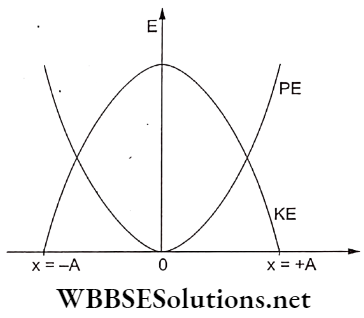
Question 8. Statement 1 Let the bob of a simple pendulum be a ball full of water. If a fine hole is made in the bottom of the ball, the time period first increases and then decreases.
Statement 2 As water flows out of the ball, its weight decreases.
Answer: 3. Statement 1 is true and Statement 2 is false.
When water gets drained out of the shell, the center of mass is lowered, thus increasing the length of the pendulum. Consequently, the time period increases. When the shell is more than half-empty, the center of mass again rises up with a decrease in the length and a decrease in the time period of the pendulum.
The time period \(T=2 \pi \sqrt{\frac{l}{g}}\) is independent of the weight of the bob.
Question 9. Statement 1 The amplitude of an oscillating pendulum decreases gradually with time.
Statement 2 The frequency of oscillations of the pendulum decreases with time.
Answer: 1. Statement 1 is true; Statement 2 is true; and Statement 2 is a correct explanation of Statement 1.
In the presence of damping (air friction), the displacement amplitude decreases exponentially with time. The frequency of oscillations also decreases with time, so that the oscillations become slow.
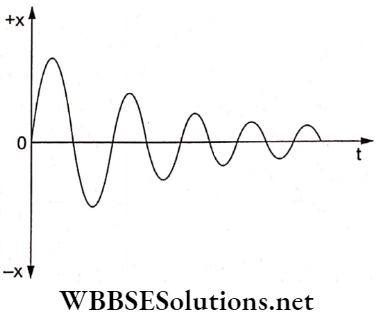
Elasticity Fluids
Question 1. Statement 1 Stress is the internal force per unit area of a body.
Statement 2 Rubber is more elastic than steel.
Answer: 3. Statement 1 is true and Statement 2 is false.
Stress is developed in a body due to the internal forces per unit area. Steel is more elastic than rubber.
Question 2. Statement 1 A hollow shaft is found to be stronger than a solid shaft made of the same material.
Statement 2 The torque required to produce a given twist in a hollow cylinder is greater than that required to twist a solid cylinder of the same material and of the same dimensions.
Answer: 1. Statement 1 is true; Statement 2 is true; and Statement 2 is a correct explanation of Statement 1.
If two cylinders of the same length, the same mass, and the same material are made such that one is solid while the other is hollow then it can be shown that the twisting couple per unit twist for a hollow cylinder is greater than that for a solid cylinder. Hence, hollow shafts are stronger.
Question 3. Statement 1 Lead is more elastic than rubber.
Statement 2 If the same load is attached to lead and rubber wires of the same cross-sectional area, the strain in the lead wire is very much less than that in the rubber wire.
Answer: 1. Statement 1 is true; Statement 2 is true; and Statement 2 is a correct explanation of Statement 1.
The material for which the stress at the elastic limit is more is said to be more elastic. This corresponds to Statement 2.
Question 4. Statement 1 A hydrogen-filled balloon stops rising after it has attained a certain height in the sky.
Statement 2 The atmospheric pressure decreases with height and becomes zero when the maximum height is attained.
Answer: 3. Statement 1 is true and Statement 2 is false.
Hydrogen is lighter than air, so it rises up due to a buoyant force. It stops rising further after some height. In the upper atmosphere, the pressure is low, so the balloon expands, and its buoyancy increases but not the pull of gravity. It stops in equilibrium. At the maximum height, the atmospheric pressure is not zero.
Question 5. Statement 1 The specific gravity of a liquid is a dimensionless quantity.
Statement 2 It is the ratio of the density of the fluid to the density of water.
Answer: 1. Statement 1 is true; Statement 2 is true; and Statement 2 is a correct explanation of Statement 1.
The specific gravity of a substance is its density relative to water. So, it is dimensionless.
Question 6. Statement 1 For a Reynolds number Re > 2000, the nature of the flow of a fluid is turbulent.
Statement 2 Inertial forces are dominant compared to the viscous forces at such a high Reynolds number.
Answer: 1. Statement 1 is true; Statement 2 is true; and Statement 2 is a correct explanation of Statement 1.
The Reynolds number is defined as the ratio
∴ \(R e=\frac{\text { inertial forces }}{\text { viscous forces }}\)
When the ratio exceeds 2000, the nature of flow becomes turbulent due to the dominance of inertial forces over viscous forces.
Question 7. Statement 1 Machine parts get jammed in winter.
Statement 2 The viscosity of a lubricant used in machine parts increases at low temperatures.
Answer: 1. Statement 1 is true; Statement 2 is true; and Statement 2 is a correct explanation of Statement 1.
In winter, when the temperature considerably drops, the viscosity of lubricating oil increases, so the oil does not reach the machine parts easily, leading to a jam inside.
Question 8. Statement 1 A thin stainless-steel needle can lay floating on a still water surface.
Statement 2 Any object floats when the buoyant force balances the weight of the body.
Answer: 2. Statement 1 is true; Statement 2 is true; but Statement 2 is not a correct explanation of Statement 1.
A steel needle presses the water surface and experiences forces due to the surface tension to keep floating. For equilibrium, the weight and the buoyant force must balance each other.
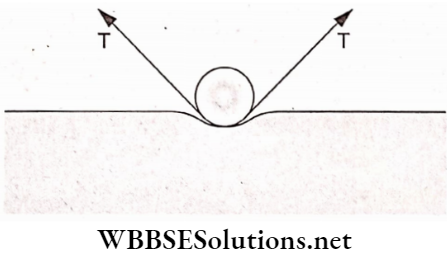
Question 9. Statement 1 The shape of an automobile is so designed that its front resembles the streamlined pattern of the fluid through which it moves.
Statement 2 The resistance offered by the fluid on streamlined objects is maximum.
Answer: 3. Statement 1 is true and Statement 2 is false.
The automobiles are designed to have a streamlined shape in the front part. This reduces the aerodynamic drag so as to minimize the resistance offered by the fluid.
Question 10. Statement 1 Turbulence is always dissipative.
Statement 2 A high Reynolds number promotes turbulence.
Answer: 2. Statement 1 is true; Statement 2 is true; but Statement 2 is not a correct explanation of Statement 1.
In a turbulent flow, an energy dissipation occurs. During the turbulent flow, the Reynolds number is high.
Question 11. Statement 1 A needle placed carefully on the surface of still water may float, whereas the ball of the same material will always sink.
Statement 2 The buoyancy of an object depends both on the material and shape of the object.
Answer: 3. Statement 1 is true and Statement 2 is false.
A needle floats on a water surface due to the force of surface tension balancing the weight. A solid sinks because the buoyant force is not sufficient to balance the weight. Buoyancy depends only on the shape.
Question 12. Statement 1 The smaller drops of a liquid resist deforming forces better than the larger drops.
Statement 2 The excess pressure inside a drop is directly proportional to its surface area.
Answer: 3. Statement 1 is true and Statement 2 is false.
The excess pressure \(\left(\Delta p=\frac{2 T}{R}\right)\) inside a smaller drop is larger, hence it offers more resistive force for deformation than a larger drop. The excess pressure varies as 1 /R and it does not depend on the surface area.
Question 13. Statement 1 The surface energy of an oil drop is the same whether placed on a glass or a water surface.
Statement 2 The surface energy is dependent only on the properties of the oil.
Answer: 5. Both Statement 1 and Statement 2 are false.
The surface tension is a molecular phenomenon and depends on cohesive and adhesive forces. So, the surface energy for an oil-glass pair is different than that for an oil-water pair. It depends on both the surfaces in contact.
Question 14. Statement 1 When the height of a capillary tube is less than the liquid rise in the capillary tube, the liquid does not overflow.
Statement 2 The product of the radius of a concave meniscus and the height of liquid in a capillary tube always remains constant.
Answer: 1. Statement 1 is true; Statement 2 is true; and Statement 2 is a correct explanation of Statement 1.
When the length of the capillary tube is insufficient, the liquid rises to the top, and the radius of curvature of the concave meniscus changes to ensure that hR remains constant.











